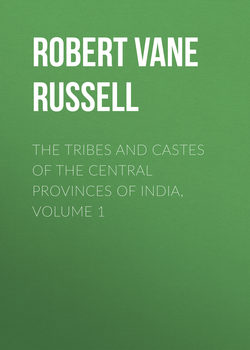Читать книгу The Tribes and Castes of the Central Provinces of India, Volume 1 - Robert Vane Russell - Страница 28
Part I.
Introductory Essay on Caste
Introductory Essay on Caste
25. Higher professional and artisan castes
ОглавлениеThe second division of the group of pure or good castes, or those from whom a Brāhman can take water, comprises the higher artisan castes:
The most important of these are the Sunār or goldsmith; the Kasār or worker in brass and bell-metal; the Tamera or coppersmith; the Barhai or carpenter; and the Halwai and Bharbhūnja or confectioner and grain-parcher. The Sānsia or stone-mason of the Uriya country may perhaps also be included. These industries represent a higher degree of civilisation than the village trades, and the workers may probably have been formed into castes at a later period, when the practice of the handicrafts was no longer despised. The metal-working castes are now usually urban, and on the average their members are as well-to-do as the cultivators. The Sunārs especially include a number of wealthy men, and their importance is increased by their association with the sacred metal, gold; in some localities they now claim to be Brāhmans and refuse to take food from Brāhmans.62 The more ambitious members abjure all flesh-food and liquor and wear the sacred thread. But in Bombay the Sunār was in former times one of the village menial castes, and here, before and during the time of the Peshwas, Sunārs were not allowed to wear the sacred thread, and they were forbidden to hold their marriages in public, as it was considered unlucky to see a Sunār bridegroom. Sunār bridegrooms were not allowed to see the state umbrella or to ride in a palanquin, and had to be married at night and in secluded places, being subject to restrictions and annoyances from which even Mahārs were free. Thus the goldsmith’s status appears to vary greatly according as his trade is a village or urban industry. Copper is also a sacred metal, and the Tameras rank next to the Sunārs among the artisan castes, with the Kasārs or brass-workers a little below them; both these castes sometimes wearing the sacred thread. These classes of artisans generally live in towns. The Barhai or carpenter is sometimes a village menial, but most carpenters live in towns, the wooden implements of agriculture being made either by the blacksmith or by the cultivators themselves. Where the Barhai is a village menial he is practically on an equality with the Lohār or blacksmith; but the better-class carpenters, who generally live in towns, rank higher. The Sānsia or stone-mason of the Uriya country works, as a rule, only in stone, and in past times therefore his principal employment must have been to build temples. He could not thus be a village menial, and his status would be somewhat improved by the sanctity of his calling. The Halwai and Bharbhūnja or confectioner and grain-parcher are castes of comparatively low origin, especially the latter; but they have to be given the status of ceremonial purity in order that all Hindus may be able to take sweets and parched grain from their hands. Their position resembles that of the barber and waterman, the pure village menials, which will be discussed later. In Bengal certain castes, such as the Tānti or weaver of fine muslin, the Teli or oil-presser, and the Kumhār or potter, rank with the ceremonially pure castes. Their callings have there become important urban industries. Thus the Tāntis made the world-renowned fine muslins of Dacca; and the Jagannāthia Kumhārs of Orissa provide the earthen vessels used for the distribution of rice to all pilgrims at the temple of Jagannāth. These castes and certain others have a much higher rank than that of the corresponding castes in northern and Central India, and the special reasons indicated seem to account for this. Generally the artisan castes ranking on the same or a higher level than the cultivators are urban and not rural. They were not placed in a position of inferiority to the cultivators by accepting contributions of grain and gifts from them, and this perhaps accounts for their higher position. One special caste may be noticed here, the Vidūrs, who are the descendants of Brāhman fathers by women of other castes. These, being of mixed origin, formerly had a very low rank, and worked as village accountants and patwāris. Owing to their connection with Brāhmans, however, they are a well-educated caste, and since education has become the door to all grades of advancement in the public service, the Vidūrs have taken advantage of it, and many of them are clerks of offices or hold higher posts under Government. Their social status has correspondingly improved; they dress and behave like Brāhmans, and in some localities it is said that even Marātha Brāhmans will take water to drink from Vidūrs, though they will not take it from the cultivating castes. There are also several menial or serving castes from whom a Brāhman can take water, forming the third class of this group, but their real rank is much below that of the cultivators, and they will be treated in the next group.
62
See article Sunār for a discussion of the sanctity of gold and silver, and the ornaments made from them.
